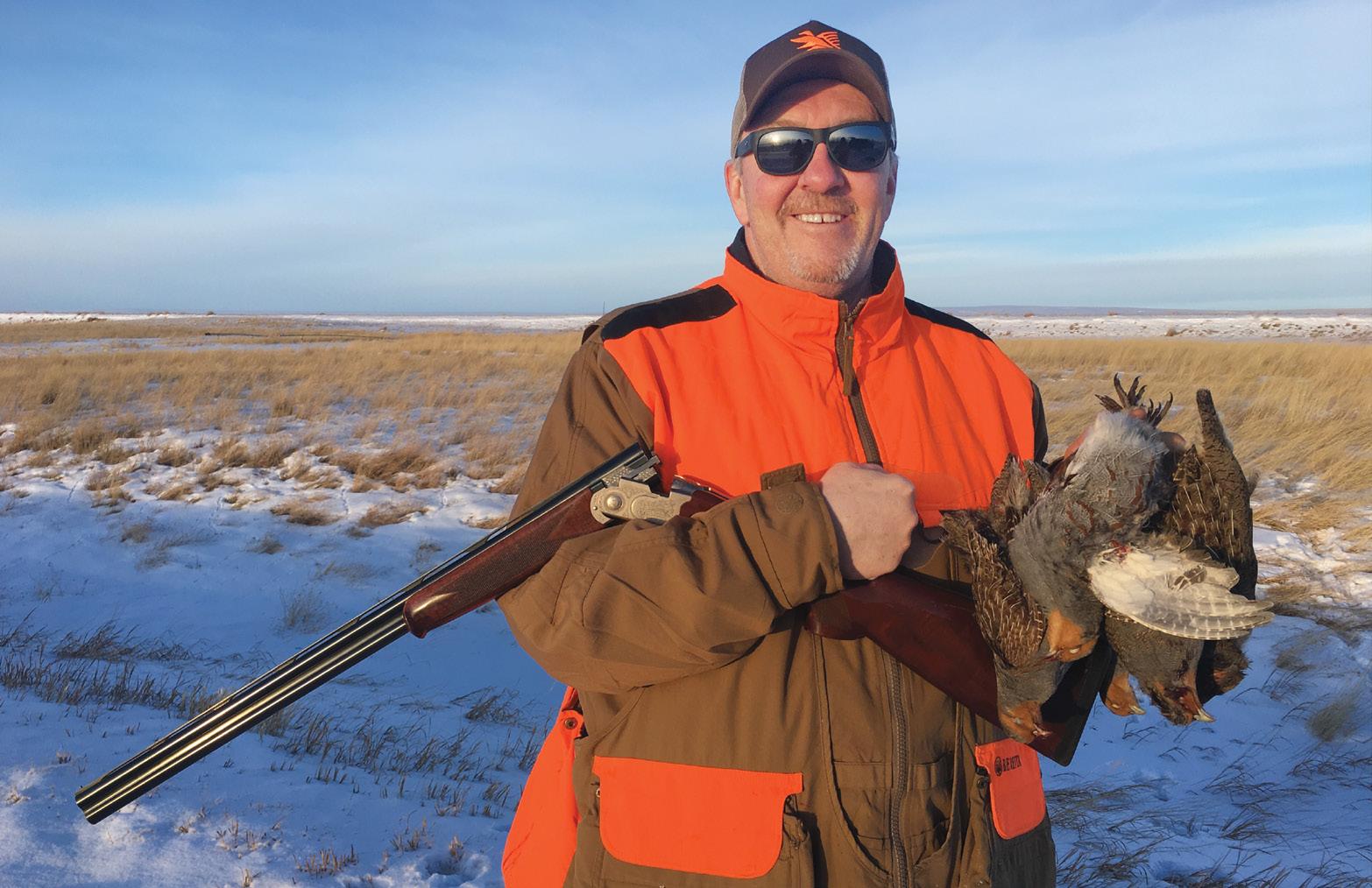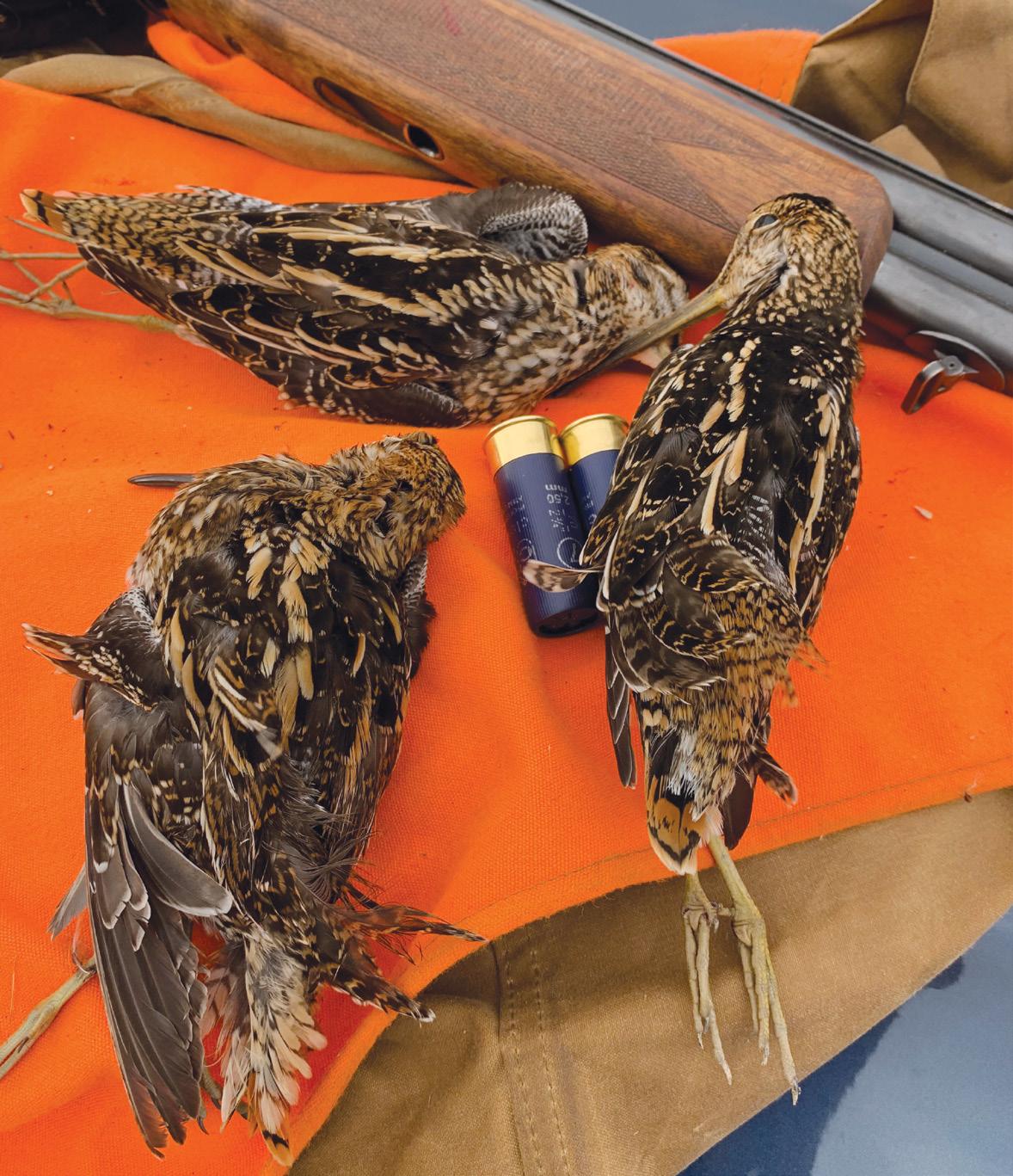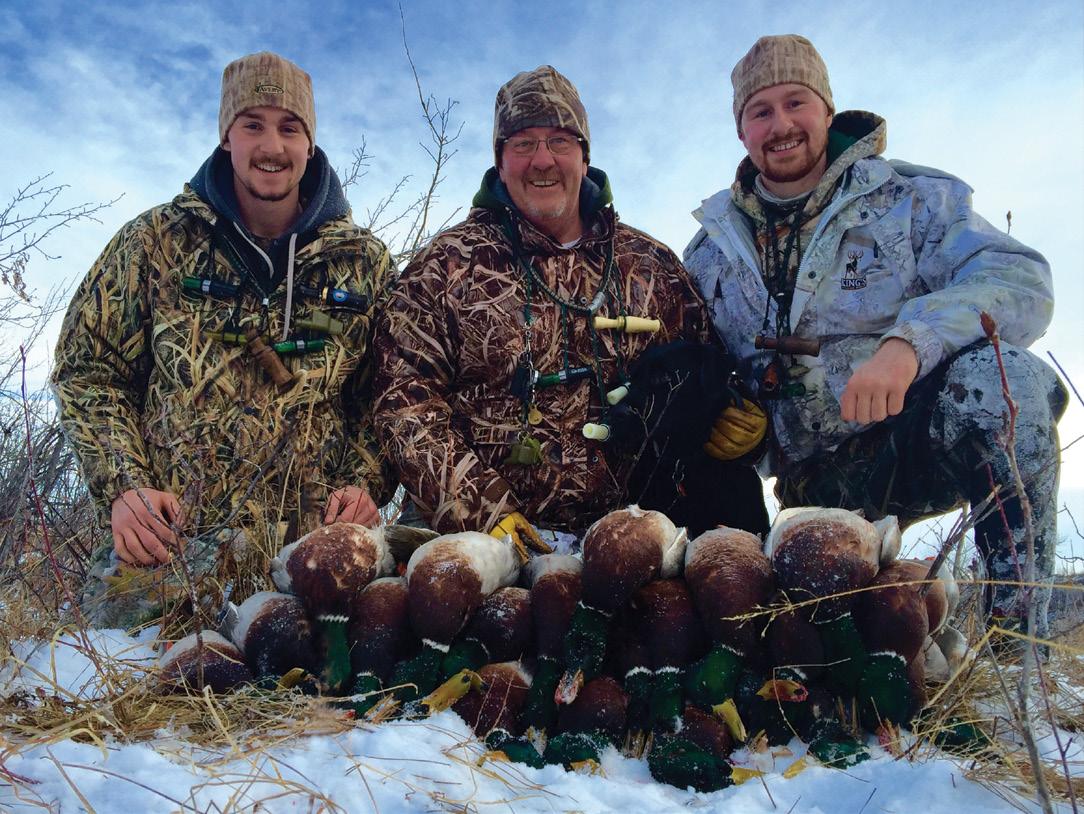
9 minute read
WINGS OVER THE WEST
we have the best of the best at our doorstep. We enjoy near endless acres of prime habitat, landowners who are generally welcoming, and friendly prairie towns with hotel diners offering bottomless cups of coffee. Most of all, we enjoy diverse and healthy populations of birds. For the uninitiated, here’s what you can expect.
SHARP-TAILED GROUSE
Advertisement
will have an abundance of snowberry, buffalo berry and other shrubs.
Early in the day, they can often be found feeding in harvested grain fields, their heads poking above the stubble, giving them away to keen-eyed hunters. As morning progresses, they will invariably move back into cover. Most often, they’re hunted with wideranging pointers and flushing dogs, and you must be prepared to put many kilometres on your boots—the reward can be numerous random flushes of singles and pairs. Without dogs, your best bet is to hunt the headlands between stubble and pasturelands, as well as the perimeters of willow sloughs.
With the extirpation of the greater prairie chicken in Canada and sage grouse populations below huntable numbers, the sharptailed grouse reigns as the true native son for prairie bird hunters. Sharptails are birds of the edge, associated with native prairie; ideal habitat for them »
As the season progresses, sharptails begin to congregate in larger coveys, but that means more eyes alert to approaching danger. Be warned—they’re the wariest of our upland game birds and they get jumpy easily, often flushing out of shooting range. For that reason, many hunters consider the early season to be more productive.
Unlike Hungarian partridge, which typically flush as a covey, sharptails are prone to flushing in succession, in a series of singles and pairs. Experienced hunters always have extra shells at the ready to quickly reload after a flush. The key is to reload before taking another step, as that will often trigger the next flush.
Most consider the dark meat of sharptails to be the poorest table fare among prairie upland birds. That may be true, but cooked low and slow in a sauce, they can make for surprisingly fine dining.
Hungarian Partridge
Known colloquially as “Huns,” Hungarian partridge were initially introduced on the Canadian prairies more than 100 years ago. Also referred to as grey partridge, they’ve been here so long and have adapted so well to our prairie climate that we generally now accept them as one of our own. It doesn’t hurt, either, that their drab brown-grey reminds us of our native grouse.
Prime habitat for these partridge can look intimidatingly barren, a sea of stubble broken up by the occasional fenceline hedgerow, slough bottom or abandoned farmyard. Rest assured the birds are out there somewhere, though—you just have to find them. Luckily, their home range is pretty small, so if you’ve found Huns in a specific location in the past, there’s still likely a covey or two nearby.
Experienced partridge hunters keep bankers hours; there’s little sense trying to catch these birds in the open stubble, where they feed on grain and insects, early in the morning. You’re better off waiting until mid-morning, after the dew is off the grass, when they’ve returned to cover; they do not like wet conditions. Search the obvious patches of habitat thoroughly, and you’ll enjoy success.
Huns will often hold tight, especially early in the season, and typically flush as a covey, so you must always be ready. Resist snap-shooting or flockshooting; you’ll either decimate these delicate birds or miss altogether. Count a Mississippi or two after the flush, pick an individual bird, and mark where it falls before swinging onto another. Huns have a unique way of disappearing when they go down, and when wounded they can squeeze into cover so tight an anorexic butterfly couldn’t slip through.

Given time, Huns will recovey after they flush. Mark where they land and go after them immediately; you’ll often flush them again as singles and pairs.
RING-NECKED PHEASANTS
Pheasants are another introduced bird on the prairies. Like Hungarian partridge, they’ve been here for more than a century, but there’s no mistaking these long-tailed, garish birds for a native. Still, we love them. In fact, more corporate logos in southern Saskatchewan and Alberta honour the pheasant than any other creature.
The reasons for our love affair with pheasants are pretty simple. For one, they are beautiful, and they’re terrific on the table. They’re also relatively slow flyers and therefore easy targets. That makes them the perfect game for introducing beginners to hunting; for many novices, our other birds or big game are simply a bridge too far.



Pheasants haven’t adapted to our climate as well as Huns have, and their populations are often supplemented by released birds. Don’t poo-poo those programs—they’re perfect for beginning hunters and dogs in training. And when raised properly, released pheasants will run, flush and fly as well as a wild rooster. They’re also wellsuited to hunters in the twilight of their career, looking for that one last bird to harvest.
That’s not to say pheasants are necessarily an easy bird to hunt. They’re cautious by nature, quick to associate the sound of vehicles and people with danger, and they’d rather run than fly. To be consistently successful, you must design and execute a game plan that not only takes into consideration where you expect the birds to hold, but also where you expect them to run to once they’ve sensed something’s up.
Ringnecks are most often found where quality food sources (cereal grains or corn,) dense grass (for nesting) and protective cover from weather and predators (shelterbelts, ditch banks, brushy coulees or cattail sloughs) are found in close proximity to each other. They can be hunted without dogs, but welltrained canines offer a significant advantage.
Pheasants don’t consistently hold for points, so expect a lot of false points. Trust your dog, though, and let him have his nose. Push all cover to the very end, and don’t be surprised if several birds erupt at once.
Snipe
Although snipe were once a popular quarry, few hunters pursue them these days. That’s a shame, because they’re terrific sport and make for unique table fare. They’re what I call a crossover bird, hunted much like traditional upland birds despite the fact they’re migratory, like waterfowl.
Throughout the fall, snipe are found on shallow flood plains dominated by grass and sedge. They have nerves of steel and will often sit tight, letting you walk by. When they do flush, you’ll nearly always be alerted by the distinctive “scaipe” sound they make. They burst from cover as little brown blurs, twisting and turning low to the ground. Resist the urge to shoot immediately, as there’s no predicting whether they’ll zig or zag. Instead, wait until they lift skyward, which they’ll typically do after 10 or 20 metres. They’re fast, too, so always be ready.
Expect to cover lots of ground searching for snipe. The particular mix of soft, flooded soil and cover they prefer can be difficult to locate, and where you find birds one year, or even one day, you won’t necessarily find them on subsequent hunts. The good news is, where you find one snipe, you’ll likely find others. In productive habitat, expect to flush four or five birds within a few hundred metres.
For the unexperienced, snipe can be difficult to differentiate from other shorebirds. One rule of thumb is that if you see a small flock of shorebirds resembling snipe on a mud flat, they’re a different species; snipe are nearly always found as singles. Remember, too, that snipe are migratory birds, meaning non-toxic shot is required under federal law.
Ducks
The Canadian prairies are at the heart of North American waterfowl production, and with some 20 different species available, it’s safe to say ducks are the West’s most popular gamebirds. And of those, mallards unquestionably stand head and shoulder above the flock. Few other sights stir a shotgunner’s passion more than hundreds, sometimes thousands, of greenheads descending into a field of peas or grain stubble.

Hunters targeting mallards generally look first to agricultural fields, where they lay out a spread of decoys, often including spinning-wing dekes. Then they wait in a blind for the first mallards to arrive, generally just as legal light peeks over the eastern horizon. On days when it all goes right, the hunt can be over in minutes.
When they don’t have the time or gear for a field shoot, duck hunters can turn to one of the thousands of ponds peppering the western landscape. On the smallest of ponds, such as willow sloughs often found within cultivated fields, huge flocks of mallards can be hunted as they water before and after feeding on waste grain.
On larger ponds, the diversity of species increases significantly; a wide variety of ducks can be taken by shoreline hunters hiding in natural cover, equipped with little more than a dozen floating decoys and a pair of waders. This is the simplest, and some would say purest, form of duck hunting, taking many of us back to our schoolboy days when time and money were rare commodities.
For an enterprising few, hunting diving ducks on large wetlands represents the epitome of waterfowl- ing. It’s wet and cold, most often requiring a boat overloaded with decoys, and it takes several hours to plan and execute. The rewards, however, are unparalleled, with canvasbacks, redheads and scaup in the bag, and memories that can never be matched by the relative starkness of a field or pond hunt.

Geese


Distribution For Canada by


While ducks may be the most commonly hunted gamebird across the prairies, geese are undoubtedly the most prized, particularly the immense Canada goose. There’s just something about the sight of young hunters holding Canada geese nearly half their size that just screams Canadiana.
Geese are almost always hunted over decoys in agricultural fields, though admittedly, some birds are harvested by pass shooters, and the odd one is taken over a wetland. Tradition supported by success, however, dictates that hunting in cropland is the standard. That means scouting is absolutely fundamental to success; some would say 75 per cent of goose hunting triumphs can be credited to dedicated scouting.
Large flocks of geese can do significant damage when grain is still in swaths, so it’s seldom a problem gaining access from farmers who don’t want to contend with these marauders. At one time, goose hunting on the prairies meant chasing Canadas, but hunters have now learned to also pursue the healthy, growing Arctic populations of snow and white-fronted, or specklebelly, geese. In fact, these alternative species are often considered better eating.

Snows, and their little cousin the Ross’s goose, are now hunted in both spring and fall as waterfowl managers look to trim their burgeoning populations. Dedicated snow goose hunters are gear junkies out of necessity, and no snow goose set-up is complete without several types of motion decoys, e-callers and as many decoys as you can possibly haul into the field.
Specklebellies are becoming the most coveted of our geese, largely because of their reputation as having the sweetest, most flavourful meat. They’re early migrators and typically depart the prairies by mid-October, so the window of opportunity for hunters is limited. While you can fool early-season or juvenile specks with Canada goose decoys, many veteran hunters say to consistently attract mature specks, with their beautiful and distinctive barred breasts, you must use dedicated specklebelly decoys.
As for Canada geese, they may not be as revered as roasting birds as they once were, but they’re still a popular menu item. These days, many hunters have turned to grinding them, either for making sausages or as ground meat for various recipes; they’re superb prepared this way.

Sandhill Cranes
With the 2020 introduction of a sandhill crane season in Alberta, hunters can now pursue these prehistoric-looking birds across all three Prairie provinces. Sandhills are ungainly in appearance, all legs, neck and bill, like avian teenagers who’ve yet to grow into their bodies. What they lack in aesthetics, however, they more than make up for in challenge. They can be frustrating to decoy and equally difficult to anchor. And their outlandish physical characteristics lead many hunters to shoot before they’re within effective range.
As with geese, cranes roost on large waterbodies, making return morning and evening trips to feed in nearby grain fields. When they don’t have far to travel between their roosting and feeding areas, they fly quite low, leading many hunters to hide along their flight path and pass shoot them as they fly over. Wounded cranes are notorious for being aggressive towards dogs and hunters alike, so be careful when approaching them and go to all lengths to ensure your retriever doesn’t get itself into a dangerous situation.
Decoying cranes offers the most excitement, but you have to pay attention to the details. Cranes see exceptionally well, so your blind must be well camouflaged or situated up against natural cover. Fullbodied crane decoys make a huge difference in your hunting success, but they’re expensive and cumbersome. Fortunately, you can get away with just a couple dozen, especially early in the season.
Often referred to as “the ribeye of the sky” for their reputation on the plate, sandhills have garnered a cult-like following of hunters. If you haven’t had the chance to hunt these birds yet, invite yourself along with the next group of crane hunters you encoun- ter. Trust me, the experience will be worth every après-hunt breakfast you have to buy in exchange. OC

ALSO SEE HUNTING EDITOR KEN BAILEY’S COLUMN ON GAINING ACCESS (PAGE 30).










